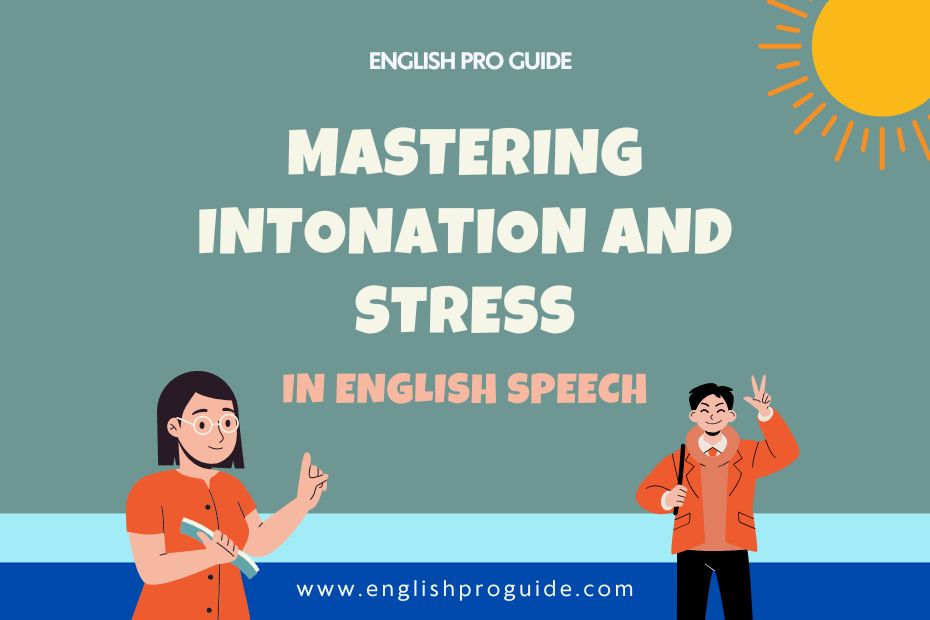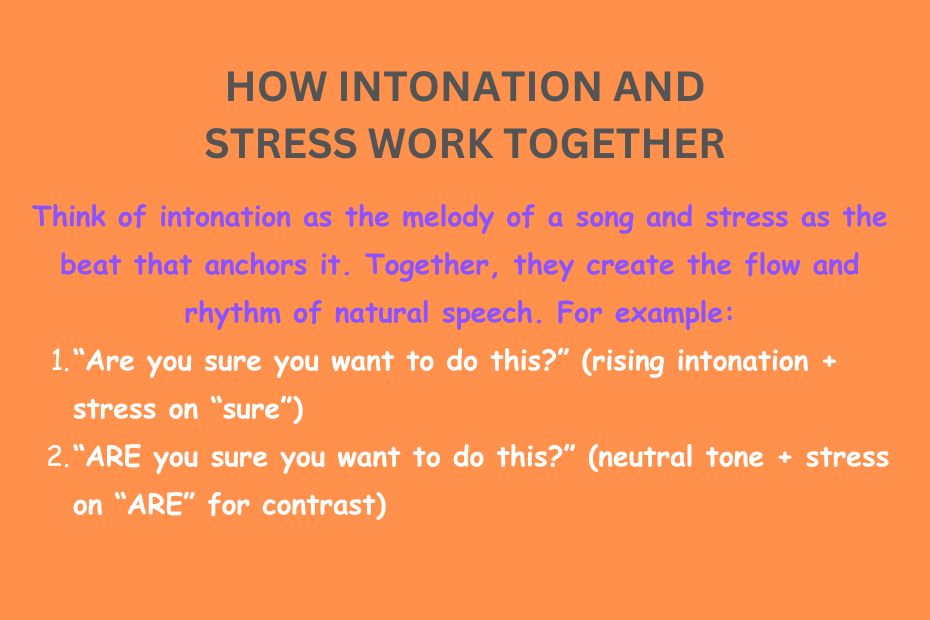Mastering Intonation and Stress in English Speech – Tips & Examples
Unlock the secrets of intonation and stress in English! Learn practical tips, real-life examples, and exercises to improve fluency and communication.
Have you ever wondered why some people sound so captivating when they speak English, while others seem robotic and hard to follow?
The secret lies in intonation and stress—two powerful tools that bring rhythm, emotion, and clarity to our words. English isn’t just about grammar or vocabulary—it’s about how you say things that make a world of difference.
Think of it as finding your unique “music” within the language.
This guide will take you through all the essentials you need to master intonation and stress in English, from understanding how they work to practical tips for using them in everyday conversations.
By the end, you’ll not just speak English—you’ll speak it with confidence and style!

What Are Intonation and Stress?
Before jumping into techniques, it’s important to understand what these terms actually mean.
Intonation: The Melody of Your Speech
Intonation refers to the rise and fall of your voice as you speak. It helps convey emotions, questions, affirmations, and even subtle attitudes.
For example, when you ask a question like “You’re coming with me?”, your voice naturally rises at the end. That’s intonation at work!
Stress: The Spotlight on Key Words
Stress is like a flashlight that lights up certain syllables or words to make them stand out.
For instance, in the word “important,” we stress the second syllable (im-POR-tant). Similarly, in a sentence like “I love ice cream!”, the word “love” gets the loudest emphasis to convey your feelings.
Together, intonation and stress form the rhythm of English, making it lively and expressive. Without them, your speech risks sounding flat or monotonous.
Relationship Between Intonation and Stress in English

What would English sound like without intonation or stress? Honestly, it’d probably sound like a monotone robot. Awkward, right?
Understanding the relationship between intonation and stress can change how you speak English entirely. These two elements work hand in hand to make language more engaging and meaningful.
How Intonation and Stress Work Together
Think of intonation as the melody of a song and stress as the beat that anchors it. Together, they create the flow and rhythm of natural speech. For example:
- “Are you sure you want to do this?” (rising intonation + stress on “sure”)
- “ARE you sure you want to do this?” (neutral tone + stress on “ARE” for contrast)
Notice how highlighting different words impacts the meaning? This seamless dance between the two makes English dynamic and easy to follow.
Common Challenges and Fixes
Learners often face hurdles like placing stress incorrectly or using flat intonation. Here are common challenges and how to solve them:
- Misplaced Stress
- Example Mistake: Saying “reCORD” instead of “REcord.”
- Fix: Practice minimal pairs—words that change meaning with stress, like “permit” (noun vs. verb).
- Flat Intonation
- Example Mistake: A question like “Are you ready?” that sounds like a statement.
- Fix: Listen and mimic native speakers to catch natural rising and falling patterns.
| Challenge | Solution |
|---|---|
| Misplaced stress | Practice word pairs like “REcord” and “reCORD.” |
| Flat intonation | Use shadowing exercises (repeat after native speakers). |
These small adjustments make a big difference in how you sound and how your message is received.
Read More: 100 Borrowed Words: How English Embraced Other Languages
Mastering Intonation and Stress Through Practical Tips
Becoming fluent in English rhythm takes effort, but it doesn’t have to feel like a chore. Below are some fun, actionable ways to practice and improve.
1. Listen and Mimic
Have you noticed how toddlers learn to speak? They mimic what they hear! You can do the same.
- How to Practice:
- Listen to English podcasts or watch movies. Focus on where the speaker’s pitch rises or falls.
- Rewind sentences and say them out loud, mimicking their tone and stress.
- Pro Tip:
Record yourself. Compare it with the speaker to ensure your rhythm matches theirs!
2. Mark Your Sentences
Use a pen or app to underline stressed words when reading aloud. It’s a great way to train your instincts.
- Example:
- “I’m going to the store to buy some milk.”
Notice how the stressed words drive the sentence’s meaning?
- “I’m going to the store to buy some milk.”
3. Practice Minimal Pairs
Words like “present” (noun) and “present” (verb) are perfect for stress training. Practice saying them aloud in varied contexts to build flexibility in your speech.
4. Shadow Conversations
Find clips of English speakers having casual conversations. Pause after each line, and repeat exactly as they say it. This mimics the natural rhythm of spoken English.
Fun exercises like these help you “feel” the language’s rhythm, making intonation and stress second nature.
Case Studies and Real-Life Examples
Want proof that these techniques work? Meet Sofia, a non-native English speaker preparing for a job interview.
Despite knowing perfect grammar, Sofia struggled to connect confidently. Through shadowing exercises and mastering falling intonation for statements like, “I am the right person for this job,” she experienced a breakthrough.
And guess what? She landed the job, thanks to her improved tone and rhythm!
Another example? Consider how stress clarifies meaning in real life:
- “I thought you were bringing the coffee.”
- “No, I said I’d bring the cookies.”
By shifting stress between “coffee” and “cookies,” the correction becomes instantly clear, avoiding any mix-ups.
Learning these tricks not only improves your skills—it transforms daily interactions into smooth, clear communication.
Read More: Tongue Twisters for Better Pronunciation (Fun for Kids and Adults)
Tools and Resources to Master Intonation and Stress
Want extra support? Here’s a handy table of resources to guide your learning:
| Tool Type | Examples | How They Help |
|---|---|---|
| Apps | Elsa Speak, YouGlish | Personal pronunciation feedback. |
| Video Courses | Rachel’s English, BBC Learn English | Visual learning of stress and intonation. |
| Classroom Games | Intonation Bingo, Stress Hunt | Makes learning interactive and fun! |
Explore these tools to spice up your practice and break the monotony!
FAQs
1. What is intonation in English?
Intonation refers to the rise and fall of your voice when speaking, helping convey meaning, tone, and emotion.
2. Why is stress important in English communication?
Stress highlights essential words, making your speech easier to understand and more dynamic.
3. How can I improve my intonation and stress?
Practice shadowing native speakers, mark stressed words in sentences, and use pronunciation apps for feedback.
4. What’s the difference between falling and rising intonation?
Falling intonation signals completion, while rising suggests questions or uncertainty.
5. Can stress placement change a sentence’s meaning?
Absolutely! Changing stress alters focus, leading to different interpretations.
Conclusion
Mastering intonation and stress in English is about more than just sounding fluent. It’s about letting your personality shine, connecting with your audience, and expressing yourself fully.
Whether you’re speaking at work, chatting with friends, or learning for fun, these techniques will serve you well.
Start with baby steps—practice daily, don’t fear mistakes, and make tools like podcasts or apps part of your routine. Soon, you’ll find yourself speaking English naturally and confidently, like a pro.
Now, why not start practicing today? The rhythm of English is waiting for you!






